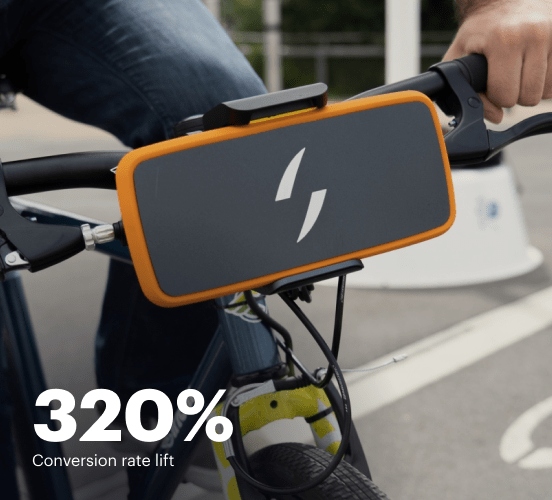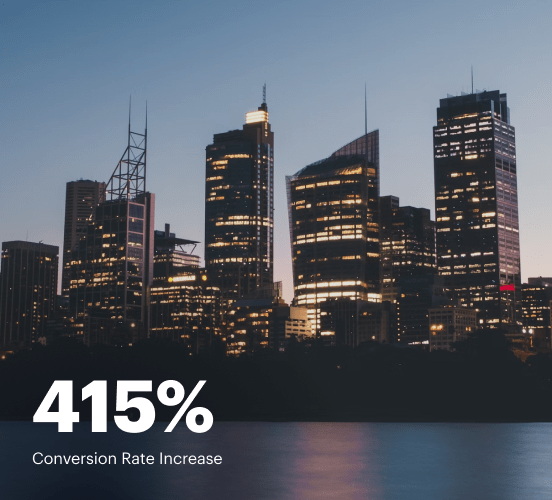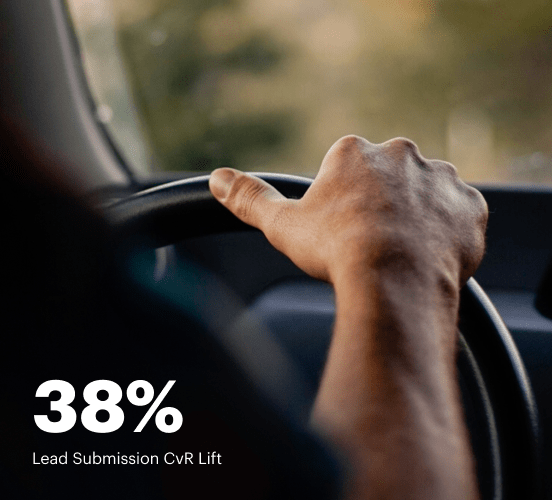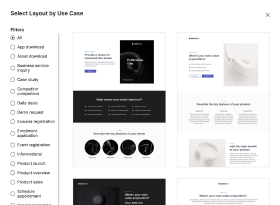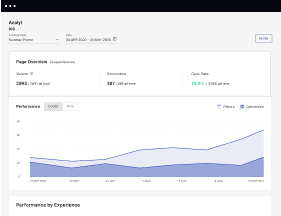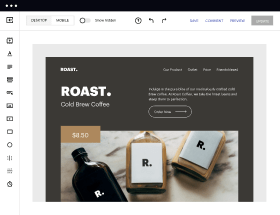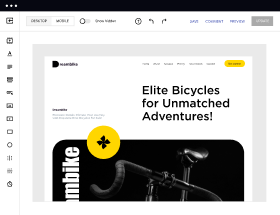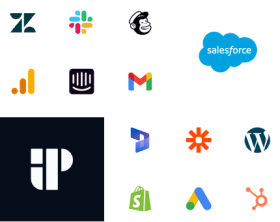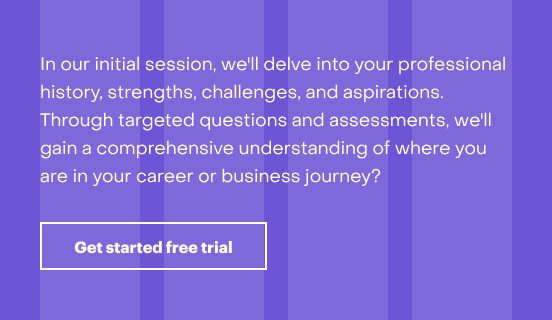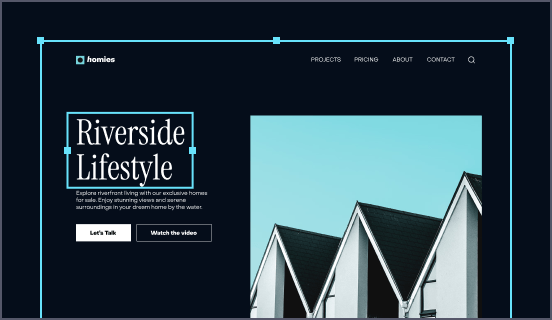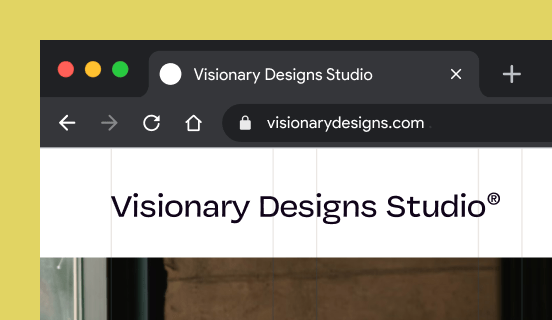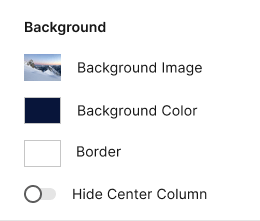Shopify vs. HubSpot: the best platform for a seamless web experience
Discover how Shopify compares to HubSpot regarding features and usability. Find out which platform provides the competitive advantage your business deserves.
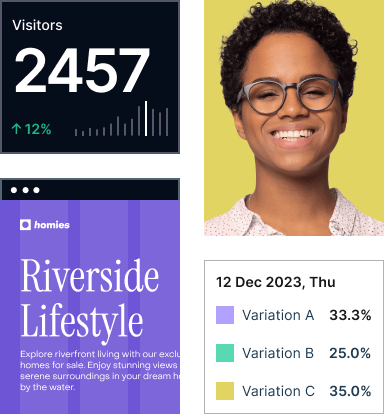
See how Instapage stacks up against the competition
| Feature | Instapage | Other builders |
| A/B Testing | ||
| Drag-and-Drop Tools | ||
| No Coding | ||
| AI Content | ||
| AdMap® | ||
| Instablocks | ||
| Real-time collaboration | ||
| Domains | Unlimited | Limited |
Easier page building without coding
Instapage offers a flexible and seamless page creation experience with a library of 500+ conversion-focused layouts, Instablocks®, a drag-and-drop builder, and AI content generation. With technologies like AMP and the Thor Render Engine®, you can create on-brand, mobile-responsive landing pages that load quickly and start converting during initial visitor clicks.
More insights — better results
Instapage lets you see in detail how each landing page experience and variation is performing so you can make targeted changes that boost page conversions. Use heatmaps for a better understanding of on-page activities, run A/B tests and AI-assisted experiments, and then track and evaluate results within robust analytics dashboards.
More personalized experiences
Instapage lets you quickly create high-performing landing pages tailored to each of your ad campaigns. Deliver personalized experiences for distinct audiences using dynamic text replacement. Effortlessly align specific advertisements to unique pages with AdMaps. Monitor audience-level metrics using our advanced data tools.
Built-in collaboration
Instapage collaboration capabilities bring your entire team together to speed up the process of landing page review, approval, and launch. No more frustrating and unnecessary revisions or edits scattered across emails. Provide instant feedback, conduct real-time page edits, and securely share your pages with outside stakeholders.
All your favorite apps working together with Instapage
With 120+ integrations, Instapage easily connects with your favorite advertising, CRM, email, e-commerce, marketing, and sales solutions.
Explore all integrations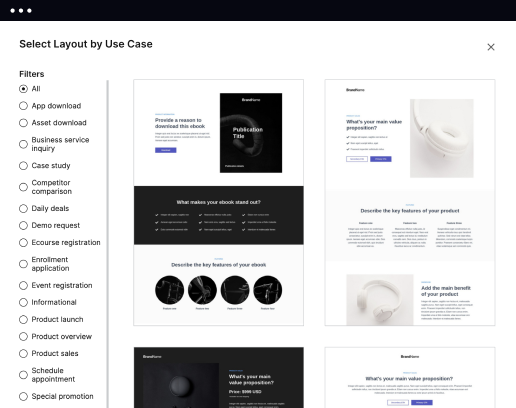
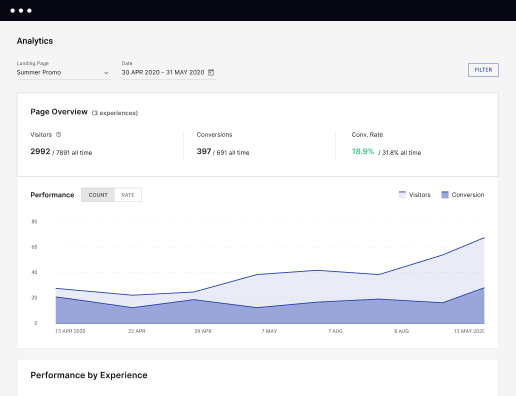
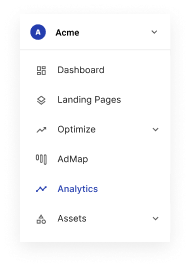
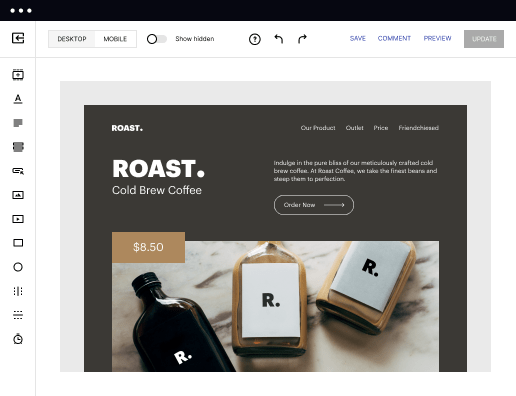
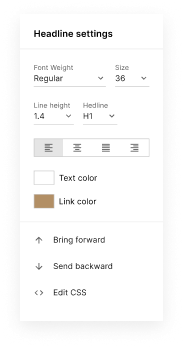
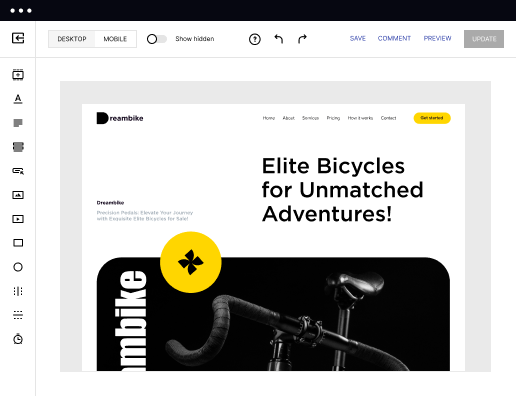
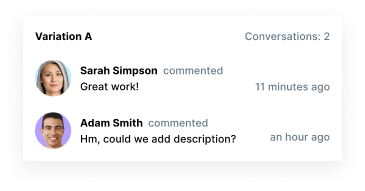
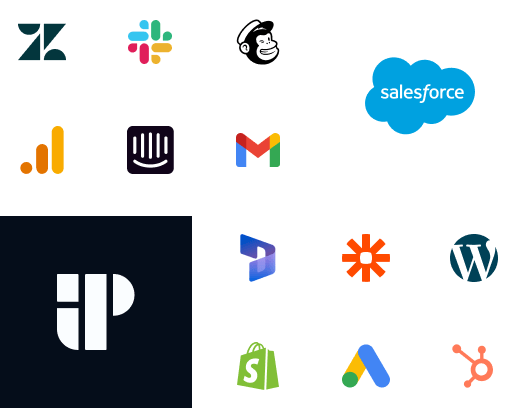
Easier page building without coding
Instapage offers a flexible and seamless page creation experience with a library of 500+ conversion-focused layouts, Instablocks®, a drag-and-drop builder, and AI content generation. With technologies like AMP and the Thor Render Engine®, you can create on-brand, mobile-responsive landing pages that load quickly and start converting during initial visitor clicks.
More insights — better results
Instapage lets you see in detail how each landing page experience and variation is performing so you can make targeted changes that boost page conversions. Use heatmaps for a better understanding of on-page activities, run A/B tests and AI-assisted experiments, and then track and evaluate results within robust analytics dashboards.
More personalized experiences
Instapage lets you quickly create high-performing landing pages tailored to each of your ad campaigns. Deliver personalized experiences for distinct audiences using dynamic text replacement. Effortlessly align specific advertisements to unique pages with AdMaps. Monitor audience-level metrics using our advanced data tools.
Built-in collaboration
Instapage collaboration capabilities bring your entire team together to speed up the process of landing page review, approval, and launch. No more frustrating and unnecessary revisions or edits scattered across emails. Provide instant feedback, conduct real-time page edits, and securely share your pages with outside stakeholders.
All your favorite apps working together with Instapage
With 120+ integrations, Instapage easily connects with your favorite advertising, CRM, email, e-commerce, marketing, and sales solutions.
Explore all integrationsLeading the way in building high-performing landing pages
Get started with Instapage in a few steps
Create your Instapage account
Start with Instapage by signing up via Google or your email. You'll get access to a free 14-day trial to discover Instapage capabilities. Feel free to cancel anytime during the 14-day trial if you decide that our product is not suitable for your business.
Build and personalize your page
Create your first landing page from scratch or choose a template from 500+ customizable layouts. Use the drag-and-drop builder to add page elements, fonts, and backgrounds, refine content with AI, or add custom HTML, Javascript, and CSS.
Review and make edits
Collaborate on page designs and streamline review processes. Invite your team members and stakeholders to review, edit, and provide feedback on your landing page. Collaborate knowing your page is confidential and only accessible to authorized users.
Publish and track page performance
Publish your page to a domain or custom URL. Connect your pages to the ads you've created and track page performance within the analytics dashboard, run A/B tests and AI experiments, analyze results, and continuously optimize your landing page to maintain high conversions.
Shopify vs. HubSpot: A Comprehensive Review with a Surprising Twist
In the world of digital marketing, platforms like Shopify and HubSpot are often at the forefront, each offering unique strengths that can cater to different business needs. Choosing between them might feel daunting, yet it’s a journey worth taking – one that can lead to enhanced online performance and improved overall customer engagement. Imagine stepping into a bustling marketplace, where every vendor showcases their finest products. Shopify is like the eager entrepreneur setting up an eye-catching storefront filled with unique items for sale, while HubSpot draws you in with an inviting array of conversational pitches, promising to nurture your business leads like gentle rain on a budding plant. However, as we navigate this landscape, we must not forget about Instapage, a formidable contender that stands quietly yet confidently on the sidelines, ready to steal the spotlight with its specialized offerings. In this guide, we will deepen our exploration of these three platforms, revealing insights that will help you decide which tool can elevate your business strategy.
Introducing the Titans of Marketing
Shopify and HubSpot have firmly established themselves as leaders in their respective fields. Shopify, praised for its eCommerce prowess, has empowered countless entrepreneurs to turn their business dreams into reality. It boasts an easy-to-use interface, attractive templates, and a wealth of integrations that make it straightforward for sellers to launch their online store. On the other side of the ring is HubSpot, known for its comprehensive suite of marketing tools that include CRM capabilities, email marketing, social media management, and analytics that enable businesses to manage relationships and track customer interactions seamlessly. Each platform brings distinct characteristics to the arena. Shopify’s platform is all about putting products in front of customers to convert them, while HubSpot focuses on building meaningful relationships to foster lasting customer loyalty. Yet, behind the curtains, Instapage lies in wait, offering tailored landing page solutions that serve as the ultimate complement or alternative to both, making it worth your consideration as we dissect this matchup.
Feature Showdown: A Closer Look
In this round, we dive deep into the key features that set Shopify and HubSpot apart. Shopify arguably leads the pack for eCommerce features, providing a host of options designed for online retailers. From customizable product pages to secure payment gateways, Shopify brings its A-game to facilitate seamless shopping experiences. HubSpot, in contrast, shines with its robust marketing automation tools, enabling businesses to segment their audience effectively and reach out with personalized content. However, let's not forget that sitting just behind the two giants is Instapage, a platform specifically designed for creating high-converting landing pages tailored to marketing campaigns. With functionality that ensures optimal conversion rates, it offers unique advantages that could sway a marketing-budget-conscious entrepreneur’s decision. Expect a feature-packed encounter as we dissect the strengths of each.
Usability Showdown: Who’s Being User-Friendly?
Usability is crucial in choosing between these two platforms. Imagine being a newbie marketer trying to land your very first sales – you want a platform that’s straightforward and intuitive, right? Here, Shopify shines brightly; it has an incredibly user-friendly dashboard that allows even the least tech-savvy to manage their storefront effortlessly. The drag-and-drop capability ensures that creating your online store is less about frustration and more about creativity and enjoyment. HubSpot, while somewhat more complex, takes the usability game to the next level with its unified approach to marketing management, helping users see their customer journey visually, almost like a map guiding you through the marketing wilderness. It may come with a learning slope, but once you’ve scaled that initial height, HubSpot’s depth is a treasure trove of insights. Finally, when we talk about usability, let’s keep an eye on Instapage. Its platform focuses particularly on landing page design and optimization, ensuring users can craft high-performing pages quickly and without hassle.
What Makes Shopify Stand Out?
- User-friendly website builder with drag-and-drop features.
- Extensive app store for endless integrations.
- Secure payment processing and a variety of payment options.
- Robust inventory management tools.
- Comprehensive reporting and analytics tools.
What HubSpot Brings to the Table?
- Advanced CRM capabilities for customer tracking.
- Intuitive email marketing tools with automation options.
- In-depth analytics to measure campaign effectiveness.
- An extensive knowledge base and training resources.
Common Strengths Shared by Shopify and HubSpot
- Strong community support and resources.
- Mobile-responsive design options.
- Seamless integration capabilities with third-party apps.
- Robust security features to protect customer data.
- Excellent scalability for growing businesses.
- User-friendly dashboards for performance tracking.
Despite the impressive capabilities of both Shopify and HubSpot, a curious observer might notice Instapage stealing glances from the sidelines, ready to pounce. Why? Instapage boasts industry-leading functionality for crafting stunning landing pages optimized for conversion, something that even these heavyweights can find challenging. For businesses aiming to maximize their online marketing strategies, turning to Instapage may very well be the informed choice that tips the scales in their favor.
Performance Assessment: Speed and Efficiency
Performance in the digital marketing landscape can often make or break a user’s experience. Page load speeds should ideally be as brisk as a spring breeze, not like molasses in January! Customers expect websites to load in under three seconds – anything longer can lead to frustrating experiences and high bounce rates. Shopify excels here, utilizing fast servers and content delivery networks to ensure online stores operate smoothly without hiccups. HubSpot’s performance also makes the cut; however, some users report sluggishness at peak usage times. It’s essential for businesses to analyze performance closely. They need a platform that won’t frustrate visitors, or else they risk losing potential sales. Instapage shines in this aspect, focusing heavily on ensuring that its landing pages load efficiently, maximizing user engagement from the get-go.
Support: How Each Platform Has Your Back
Support channels can be a deciding factor when choosing between Shopify and HubSpot. Shopify prides itself on its 24/7 customer support, which includes live chat, email exchanges, and a vibrant community forum where users can engage with one another. HubSpot also excels, with comprehensive support that offers community resources, extensive documentation, and educational tools such as HubSpot Academy. Imagine these support teams as trustworthy sidekicks, ready to swoop in with relatively quick saves, guiding users through any challenges they might encounter. In the digital landscape, having reliable support can make all the difference in transforming a stressful situation into a seamless experience.
Pricing Factors: What's the Cost?
Benefits of Shopify's Pricing Approach
- Transparent pricing with no hidden fees.
- Multiple tiered options for budgets of all sizes.
- Comprehensive features included at each level.
- 30-day free trial to explore before commitment.
Advantages of HubSpot's Pricing Strategy
- Free tier available that offers essential CRM features.
- Pay-as-you-go model for specific functionalities.
- Diverse pricing ranges catering to startups to large enterprises.
- Robust deal tracking and project management at competitive rates.
As we close the discussion on pricing, both Shopify and HubSpot present compelling offers. Shopify’s clear-cut pricing model allows businesses to see precisely what they’re getting without unexpected costs creeping in, appealing particularly to newer entrepreneurs. In contrast, HubSpot's pay-as-you-go approach provides flexibility, hence attracting various businesses. Instapage steps in with its own unique pricing strategy, reasoned to be exceptionally cost-effective, making it a worthwhile option for those primarily focused on landing page optimization.
A transparent overview of pricing plans is vital for making informed decisions. It's important to remember – sometimes the least expensive option holds hidden value, or the higher-priced choice implies a wealth of benefits that transcend the simple task it undertakes. Comparing the features against potential ROI can reveal the best-suited platform for your business needs.
Instapage: The Calm Presence Amidst the Storm
Introducing Instapage—it’s as if great mentors have been quietly observing and waiting for the perfect moment to offer their expertise. Instapage specializes in crafting professional, conversion-optimized landing pages, unlike Shopify and HubSpot, which cater to broader areas of eCommerce and sales funnels. Its unique offerings focus on A/B testing and analytics, empowering marketers to refine their landing page strategies and improve conversion rates significantly. Users who prioritize landing page effectiveness without the need for full-fledged eCommerce features may find Instapage the secret weapon that tops off their marketing arsenal. Exploring and enhancing your marketing efforts can lead to remarkable results, and Instapage provides the perfect tools to achieve this.
In this evolving landscape, making informed choices about the platforms you select is essential. As you navigate towards your business goals, consider how each of these platforms could play a role in your success story. Instapage emerges not just as an option but as a step towards simplifying your journey and optimizing your marketing strategy, poised to help you flourish in the digital age.
FAQs
Try the most advanced landing page platform today
Get started

